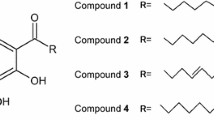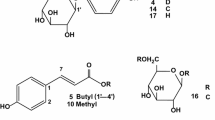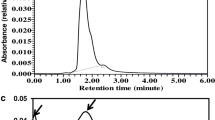Summary
Phenolic and catecholic compounds were synthesized, by combination with cysteine or cysteamine through thioether bond, and their antimelanoma and melanocytotoxic effects were evaluated. Among nine compounds tested, 4-S-cysteaminylphenol (CAP) resulted in an increase in the life span (% ILS) of melanoma-bearing mice and in the growth inhibition (% GI) of melanoma tissue. 4-S-Cysteinylphenol (CP) and its methyl ester form also showed some increase in % GI. The 2-S-isomers of CP and CAP and diphenolic derivatives of CP did not show any significant antimelanoma effect. In addition, the s.c. injection of 4-S-CAP and 4-S-CP, in particular 4-S-CAP, caused the depigmentation of black hair which was manifested by loss of functioning melanocytes, as seen under light microscopy. The 4-S-CAP appears to provide a basis for development of a new class of antimelanoma and melanocytotoxic agents that are more stable than catecholic compounds, which have been most widely utilized as a source of rational chemotherapy for malignant melanoma.
Similar content being viewed by others
References
Bleehen SS (1973) The effect of 4-isopropylcatechol on the Harding-Passey melanoma. Pigment Cell 1:202–207
Boekelheide K, Graham DG, Mize PD, Koo EH (1980) Melanocytotoxicity and the mechanism of activation of gamma-l-glutaminyl-4-hydroxybenzene. J Invest Dermatol 75:322–327
Burger PC, Kemper LA, Vogel FS (1979) The cytotoxicity of gamma-1-glutaminyl-4-hydroxybenzene for cells that contain tyrosinase, a study of melanocytes in the hair follicle of the mouse. Cancer Res 39:1494–1503
Chavin C, Jelonek Jr EJ, Reed AH, Binder LR (1980) Survival of mice receiving melanoma transplants is promoted by hydroquinone. Science 208:408–410
Comis RL (1976) DTIC (NSC-45388) in malignant melanoma: a perspective. Cancer Treat Rep 60:165–173
Freireich EJ, Gehan EA, Rall DP, Schmidt LH, Skipper HE (1960) Quantitive comparison of toxicity of anticancer agents in mouse, rat, hamster, dog, monkey, and man. Cancer Chemother Rep 50:219–244
Fujita K, Ito S, Yamamoto Y, Takeutchi J, Shamoto M, Nagatsu T (1980) Selective toxicity of 5-S-cysteinyldopa, a melanin precursor, to tumor cells in vitro and in vivo. Cancer Res 40:2543–2546
Geran RI, Greenberg NH, Macdonald MM, Schumacher AM, Abbott BJ (1972) Protocols for screening chemical agents and natural products against animal tumors and other biological systems (3rd edn). Cancer Chemother Rep 3:1–85
Graham DG, Tiffany SM, Vogel FS (1978) The toxicity of melanin precursors. J Invest Dermatol 70:113–116
Hill HZ, Hill GJ, Miller CL, Pfaller M, Weiss K, Galin M (1979) Effect of 5-(3,3-dimethyl-1-triazeno) imidazole-4-carboxamide, 1-(2-chloroethyl)-3-(4-methylcyclohexyl)-1-nitrosourea, and l-phenylalanine mustard on B16, Cloudman S91, and Harding-Passey mouse melanomas. Cancer Res 39:934–939
Hill GJ, Metter GE, Drementz EF, Fletcher WS, Golomb FM, Ramirez G, Grage TB, Mose SE, (1979) DTIC and combination therapy for melanoma. II. Escalating schedules of DTIC with BCNU, CCNU, and vincristine. Cancer Treat Rep 63:1989–1992
Ito S, Inoue S, Yamamoto Y, Fujita K (1981) Synthesis and antitumor activity of cysteinyl-3,4-dihydroxyphenylalanines and related compounds. J Med Chem 24:673–677
Jimbow K, Kukita A (1984) Unique location of melanoma, types of chemotherapy and immunotherapy and survival of melanoma patients in Japan. Clin Oncol 3:477–492
Jimbow K, Obata H, Pathak MA, Fitzpatrick TB (1974) Mechanism of depigmentation by hydroquinone. J Invest Dermatol 62:436–449
Jimbow K, Miyake Y, Homma K, Yasuda K, Izumi Y, Tsutsumi A, Ito S (1984) Characterization of melanogenesis and morphogenesis of melanosomes by physicochemical properties of melanin and melanosomes in malignant melanoma. Cancer Res 44:1128–1134
Morrison ME, Yagi MJ, Cohen G (1985) In vitro studies of 2,4-dihydroxyphenylalanine, a prodrug targeted against malignant cells. Proc Natl Acad Sci USA 82:2960–2964
Padgette SR, Herman HH, Han JH, Pollock SH, May SW (1984) Antihypersensitive activities of phenyl aminoethyl sulfides, a class of synthetic substrates for dopamine hydroxylase. J Med Chem 27:1354–1357
Parsons PG (1985) Modification of dopa toxicity in human tumour cells. Biochem Pharmacol 34:1801–1807
Pawelek J (1976) Factors regulating growth and pigmentation of melanoma cells. J Invest Dermatol 6:201–209
Rosowsky A, Wick MM, Kim SH (1979) Structural analogues of l-glutamic acid gamma-(4-hydroxyanilide) and gamma-(3,4-dihydroxyanilide) as potential agents against melanoma. J Med Chem 22:1034–1037
Sugano H, Sugano I, Jimbow K, Fitzpatrick TB (1975) Tyrosinase-mediated inhibition of in vitro leucine incorporation into mouse melanoma by 4-isopropylcatechol. Cancer Res 35:3126–3130
Vogel FS, Kemper LAK, Jeffs PW, Cass MW, Graham DG (1979) Gamma-l-glutaminyl-4-hydroxybenzene for cells that contain tyrosinase, a study of melanocytes in the hair follicle of the mouse. Cancer Res 39:1494–1503
Wick MM (1979) 3,4-Dihydroxybenzylamine: a dopamine analog with enhanced antitumor activity against B16 melanoma. JNCI 63:1465–1467
Wick MM (1980) An experimental approach to the chemotherapy of melanoma. J Invest Dermatol 74:63–65
Wick MM (1980) Levodopa and dopamine analogs as DNA polymerase inhibitors and antitumor agents in human melanoma. Cancer Res 40:1414–1418
Wick MM (1982) Therapeutic effect of dopamine infusion on human malignant melanoma. Cancer Treat Rep 66: 1657–1659
Wick MM, Kramer RA, Gorman M (1978) Enhancement of l-dopa incorporation into melanoma by dopa decarboxylase inhibition. J Invest dermatol 70:358–360
Author information
Authors and Affiliations
Rights and permissions
About this article
Cite this article
Miura, S., Ueda, T., Jimbow, K. et al. Synthesis of cysteinylphenol, cysteaminylphenol, and related compounds, and in vivo evaluation of antimelanoma effect. Arch Dermatol Res 279, 219–225 (1987). https://doi.org/10.1007/BF00417318
Received:
Issue Date:
DOI: https://doi.org/10.1007/BF00417318




